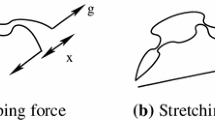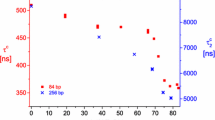Abstract
Double-stranded DNA (dsDNA) undergoes a structural transition to single-stranded DNA (ssDNA) in many biologically important processes such as replication and transcription. This strand separation arises in response either to thermal fluctuations or to external forces. The roles of ions are twofold, shortening the range of the interstrand potential and renormalizing the DNA elastic modulus. The dsDNA-to-ssDNA transition is studied on the basis that dsDNA is regarded as a bound state while ssDNA is regarded as an unbound state. The ground state energy of DNA is obtained by mapping the statistical mechanics problem to the imaginary time quantum mechanics problem. In the temperature–force phase diagram the critical force F c (T) increases logarithmically with the Na+ concentration in the range from 32 to 110 mM. Discussing this logarithmic dependence of F c (T) within the framework of polyelectrolyte theory, it inevitably suggests a constraint on the difference between the interstrand separation and the length per unit charge during the dsDNA-to-ssDNA transition.






Similar content being viewed by others
References
Owczarzy, R., Vallone, P.M., Gallo, F.J., Paner, T.M., Lane, M.J., Benight, A.S.: Predicting sequence-dependent melting stability of short duplex DNA oligomers. Biopolymers 44, 217–239 (1998)
Nelson, P.: Biological Physics: Energy, Information, Life. W. H. Freeman, New York (2003)
Palmeri, J., Manghi, M., Destainville, N.: Thermal denaturation of fluctuating finite DNA chains: the role of bending rigidity in bubble nucleation. Phys. Rev. E 77, 011913 (2008)
Bockelmann, U., Thomen, P., Heslot, F.: Dynamics of the DNA duplex formation studied by single molecule force measurements. Biophys. J. 87, 3388–3396 (2004)
Gelbart, W.M., Bruinsma, R.F., Pincus, P.A., Parsegian, V.A.: DNA-inspired electrostatics. Phys. Today 53, 38–44 (2000)
Danilowicz, C., Lee, C.H., Kim, K., Hatch, K., Coljee, V.W., Kleckner, N.E., Prentiss, M.: Single molecule detection of direct, homologous, DNA/DNA pairing. Proc. Natl. Acad. Sci. USA 106, 19824–19829 (2009)
Cluzel, P., Lebrun, A., Heller, C., Lavery, R., Viovy, J.L., Chatenay, D., Caron, F.: DNA: an extensible molecule. Science 271, 792–794 (1996)
Vologodskii, A.: DNA extension under the action of an external force. Macromolecules 27, 5623–5625 (1994)
Cherstvy, A.G.: Torque-induced deformations of charged elastic DNA rods: thin helices, loops, and precursors of DNA supercoiling. J. Biol. Phys. 37, 227–238 (2011)
Neukirch, S., Marko, J.F.: Analytical description of extension, torque, and supercoiling radius of a stretched twisted DNA. Phys. Rev. Lett. 106, 138104 (2011)
Cocco, S., Monasson, R., Marko, J.F.: Force and kinetic barriers to initiation of DNA unzipping. Phys. Rev. E 65, 041907 (2002)
Kim, J., Jeon, J., Sung, W.: A breathing wormlike chain model on DNA denaturation and bubble: effects of stacking interactions. J. Chem. Phys. 128, 055101 (2008)
Jeon, J., Sung, W.: An effective mesoscopic model of double-stranded DNA. J. Biol. Phys. 40, 1–14 (2014)
Bockelmann, U., Essevaz-Roulet, B., Heslot, F.: DNA strand separation studied by single molecule force measurements. Phys. Rev. E 58, 2386 (1998)
Shankar, R.: Principles of Quantum Mechanics. Plenum Press, New York (1994)
Nelson, D.R.: Statistical physics of unzipping DNA. Preprint cond-mat/0309559
Marko, J.F., Siggia, E.D.: Stretching DNA. Macromolecules 28, 8759–8770 (1995)
Podgornik, R., Hansen, P.L., Parsegian, V.A.: Elastic moduli renormalization in self-interacting stretchable polyelectrolytes. J. Chem. Phys. 113, 9343–9350 (2000)
Chalikian, T.V., Völker, J., Eric Plum, G., Breslauer, K.J.: A more unified picture for the thermodynamics of nucleic acid duplex melting: a characterization by calorimetric and volumetric techniques. Proc. Natl. Acad. Sci. USA 96, 7853–7858 (1999)
Sebastiani, F., Pietrini, A., Longo, M., Comez, L., Petrillo, C., Sacchetti, F., Paciaroni, A.: Melting of DNA nonoriented fibers: a wide-angle X-ray diffraction study. J. Phys. Chem. B 118, 3785–3792 (2014)
Baumann, C.G., Smith, S.B., Bloomfield, V.A., Bustamante, C.: Ionic effects on the elasticity of single DNA molecules. Proc. Natl. Acad. Sci. USA 94, 6185–6190 (1997)
Danilowicz, C., Kafri, Y., Conroy, R.S., Coljee, V.W., Weeks, J., Prentiss, M.: Measurement of the phase diagram of DNA unzipping in the temperature–force plane. Phys. Rev. Lett. 93, 78101 (2004)
Zhang, X., Chen, H., Le, S., Rouzina, I., Doyle, P.S., Yan, J.: Revealing the competition between peeled ssDNA, melting bubbles, and S-DNA during DNA overstretching by single-molecule calorimetry. Proc. Natl. Acad. Sci. USA 110, 3865–3870 (2013)
Wenner, J.R., Williams, M.C., Rouzina, I., Bloomfield, V.A.: Salt dependence of the elasticity and overstretching transition of single DNA molecules. Biophys. J. 82, 3160–3169 (2002)
Nguyen, V.D., Nguyen, T.T., Carloni, P.: DNA like-charge attraction and overcharging by divalent counterions in the presence of divalent co-ions. J. Biol. Phys. 43, 185–195 (2017)
Rau, D.C., Parsegian, V.A.: Direct measurement of the intermolecular forces between counterion-condensed DNA double helices. Biophys. J. 61, 246–259 (1992)
Xiao, Y., Huang, Z., Wang, S.: An elastic rod model to evaluate effects of ionic concentration on equilibrium configuration of DNA in salt solution. J. Biol. Phys. 40, 179–192 (2014)
Metzler, R., Hanke, A.: Knots, bubbles, untying, and breathing: probing the topology of DNA and other biomolecules. In: Rieth, M., Schommers, W (eds.) Handbook of Theoretical and Computational Nanotechnology. American Scientific Publishers, Ranch (2006)
Rybenkov, V.V., Cozzarelli, N.R., Vologodskii, A.V.: Probability of DNA knotting and the effective diameter of the DNA double helix. Proc. Natl. Acad. Sci. USA 90, 5307–5311 (1993)
Grgičin, D., Dolanski Babić, S., Ivek, T., Tomić, S., Podgornik, R.: Effect of magnesium ions on dielectric relaxation in semidilute DNA aqueous solutions. Phys. Rev. E 88, 052703 (2013)
Acknowledgements
The author is grateful to M. Fuangfoong and to C. Pattamaprom for their insightful discussions. This work has been supported by the DPST-graduate startup research grant, contract number 24/2557. He would like to express his appreciation to the anonymous reviewers for their constructive comments and invaluable suggestions.
Author information
Authors and Affiliations
Corresponding author
Ethics declarations
Conflict of interest
The author declares that he has no conflicts of interest.
Appendices
Appendix A: Ground state eigenenergy of unperturbed Hamiltonian
We derive the expression of the ground state eigenenergy E0(0), (21), of the unperturbed Hamiltonian \(\widehat {\textbf {H}}_{0}\). The ground state eigenenergy \(E_{0}^{(0)} = < \psi _{0}^{(0)} | \widehat {\textbf {H}}_{0} | \psi _{0}^{(0)} >\) gives
where we define the kinetic-like energy as
and we define the potential energy, due to the attractive Coulomb potential as,
Without loss of generality, let the external constant force F be in the \(\widehat {\textbf {r}}\)-direction, i.e., \(\textbf {F}{\kern -.5pt} ={\kern -.5pt} F\widehat {\textbf {r}}\). The Laplacian term takes the form
in which to obtain the last line we use (19) for the unperturbed ground state eigenfunction ψ0(0)(r). Substituting (33) in (31) and use the normalization of ψ0(0)(r) gives the kinetic-like energy
The potential energy is
Adding the kinetic-like energy E k with the potential energy E p yields the ground state eigenenergy of the unperturbed Hamiltonian
which is (21) in the main text.
Appendix B: First-order correction to ground state eigenenergy of full Hamiltonian
We derive the first-order correction, (23), to the ground state eigenenergy of full Hamiltonian \(\widehat {\textbf {H}}\). Using the perturbation \(\widehat {\textbf {H}}^{\prime }\), (13), and the ground state eigenfunction of the unperturbed Hamiltonian ψ0(0)(r), (19), we obtain
where defining C ≡ a/2λ D (1 − (Fa/k B T)). The second summation in parentheses \(S \equiv {\sum }_{n=0}^{\infty } (-1)^{n} C^{n}\), which is a geometric series equal to 1/(C + 1). The first summation in parentheses \({\sum }_{n=0}^{\infty } (-1)^{n} nC^{n} = C\partial S/\partial C\) equals − C/(C + 1)2. Hence, we can write explicitly, upon substituting the definition of C,
which is (23) in the main text.
Rights and permissions
About this article
Cite this article
Amnuanpol, S. Ionic effects on the temperature–force phase diagram of DNA. J Biol Phys 43, 535–550 (2017). https://doi.org/10.1007/s10867-017-9468-1
Received:
Accepted:
Published:
Issue Date:
DOI: https://doi.org/10.1007/s10867-017-9468-1




